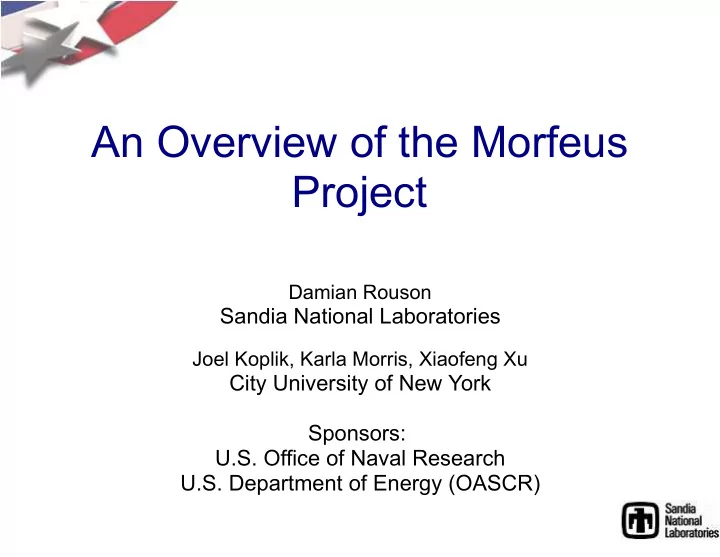

An Overview of the Morfeus Project Damian Rouson Sandia National Laboratories Joel Koplik, Karla Morris, Xiaofeng Xu City University of New York Sponsors: U.S. Office of Naval Research U.S. Department of Energy (OASCR)
Outline Introduction Methodology Results Conclusion
Outline Introduction ➢ Motivation ➢ Objectives ➢ Previous work Methodology Results Conclusion
Motivation Published OOD patterns in scientific programming are rare – especially in Fortran 2003/2008. Conventional wisdom suggests that the higher-level abstractions characteristic of OOP impose performance penalties.
Objectives To move scientific programmers to higher-level, platform-agnostic yet scalable abstractions. To demonstrate general OOD patterns & distill new domain-specific patterns from multiphysics applications in Fortran. To construct an open-source framework that encourages the use of the demonstrated patterns.
Previous Work: Patterns Building architecture: Alexander et al. Vol. III (1975) Positive Outdoor Space Julian Street Inn Shelter for the Homeless Vol. II (1977) San Jose, CA Vol. I (1979)
Previous Work: OOD Patterns Software architecture: Gamma et al. (1995) Scientific software architecture: Gardner & Manduchi (2007) 1995 Mediator 2007
Previous Work: Patterns in Fortran F95: Decyk & Gardner (2006-'07) F03: Markus (2008) F03: Rouson, Adalsteinsson & Xia (2010) Puppeteer: Scientific Software Design: The Object-Oriented Way Climate Damian W. I. Rouson Jim Xia aggregates Xiaofeng Xu Atmosphere Ice Ocean 2011
Outline Introduction Methodology ➢ Language selection ➢ Pattern definition Results Conclusion
Why Fortran? Scientific programmers rule! Mathematical expressiveness: ➢ User-defined operators: .div. , .grad. , .curl. , etc. ➢ Multidimensional arrays ➢ Array operations Platform-agnostic parallelism (Fortran 2008) Automatic memory management: ➢ Automatic re-sizing of arrays ➢ Automatic destruction of dynamically allocated arrays/objects.
What's a pattern? A common solution to a recurring OOD problem. Four essential elements: ➢ The name ➢ The problem ➢ The solution ➢ The consequences Additional elements: ➢ Also known as... ➢ Known uses. ➢ Related patterns. ➢ Sample implementation.
Multiphysics with Morfeus Quantum vortices (red) & classical Particles in liquid metal MHD vortices (blue) in superfluid helium. (red=fastest, blue=slowest) [Morr is et al., PRL 2008] [Rouson et al., PoF 2008] t=0. 4 T 90 80 70 180 190 200 210 220 X Lattice Boltzman blood flow with & Optical turbulence in the ABL. without stent. [Xu & Lee IJNMF 2008] [Morris et al., JoT sub. 2010]
Software Stack Application Concrete classes. Abstract class framework. Morfeus OO Interface ForTrilinos F2003 Interface } Procedural bindings C Headers CTrilinos Extern “C”{} Distributed C++ objects Trilinos
Trilinos ● Heroux et al. (1995) “An Overview of the Trilinos Project,” ACM TOMS . ● Over 50 packages : linear, nonlinear, & eigensolvers; optimization; automatic differentiation; load balancing,... ● Establishes consistent, professional software engineering practices for over 50 packages: ● Automated nightly multi-platform build (CMake) ● Automated test/notification/dashboard (CDash) ● State-of-the-art repository (Git) ● Mailing lists (Mailman) ● Web-based issue tracking (Bugzilla) ● Automated documentation (Doxygen)
Outline Introduction Methodology Results ➢ Abstract Calculus ➢ Abstract Factory & Factory Method ➢ Object & Surrogate Conclusion
Abstract Calculus Pattern “Software abstractions should resemble blackboard abstractions.” Kevin Long, Texas Tech. U. Blackboard abstraction Software abstraction u = u x,t class(field),pointer::u,du_dt u x =0,t =u 0 c all u%boundary(x,0,u0) u t ≡∂ u /∂ t u%t() u n 1 = u n u t n t u = u + u%t()*dt u t = ν u xx − uu x du_dt = nu*u%xx() – u*u%x()
Scalability du_dt = nu*u%xx() – u*u%x() Synchronization Purely functional operators and methods. ⇒ Highly asynchronous. ⇒ Blurs the boundary ⇒ between task & data parallelism. ⇒
Factory Patterns The problem: ➢ GoF Philosophy: “Program to an interface, not an implementation.” ➢ Abstract classes model interfaces. ➢ Opposing force: Abstract classes cannot be instantiated.
Factory Patterns The Abstract Factory solution: ➢ “Provide an interface for creating families of related or dependent objects without specifying their concrete classes.” GoF The Factory Method solution: ➢ “Define an interface for creating an object, but let subclasses decide which class to instantiate. Factory method lets a class defer instantiation to subclasses.” GoF
Class Diagram FieldFactory Field + create() returns Periodic6thOrder Periodic6thFactory constructs + create() Legend “Implements” + Public Abstract Type deferred_binding()
Trilinos-Based Client program main ! ... #ifdef HAVE_MPI type(Epetra_MpiComm) :: comm #else type(Epetra_SerialComm) :: comm #endif class(field), pointer :: u class(field), pointer :: u class(field_factory), allocatable :: field_creator allocate(periodic_6th_factory::field_creator)
Trilinos-Based Client #ifdef HAVE_MPI call MPI_INIT(ierr) comm = Epetra_MpiComm(MPI_COMM_WORLD) #else comm = Epetra_SerialComm() #endif initial => u_initial u => field_creator%create(initial,resolution) !.. do while t < t_final dt = u%euler_step(nu,grid_resolution) u = u + (nu*u%xx()*nu - u*u%x())*dt t = t + dt end do #ifdef HAVE_MPI call MPI_FINALIZE(rc) #endif call u%force_finalize end program
Object Pattern The problem: Robust design requires a degree of uniformity: ➢ Consistent desirable behavior, e.g. leak-free memory management. ➢ Universal referencing. Opposing force: ➢ Too much uniformity feels like handcuffs.
Object Pattern The solution: ➢ Define a universal parent class hierarchy from which every class in the package inherits the desired behavior/interface. ➢ Use the Object class hierachy to ensure low-level services, e.g., those likely to be considered as candidates for future inclusion in the language.
Class Model Hermetic + cpp_delete() aggregates extends Universal Ref_Counter aggregates Object Pattern implements Surrogate Pattern Multivector extends Vector extends Field
Outline Introduction Methodology Results Conclusion ➢ Summary ➢ Future work ➢ Acknowledgements
Summary Abstract Calculus illuminates a path toward highly asynchronous computing that blurs the task/data parallel distinction Fortran 2003 appears to have the expressiveness to support the general GoF design patterns in multiphysics applications. Several domain-specific and language-specific patterns emerge along the way.
Future Work Implement an Abstract Calculus based on Fortran 2008 coarray PGAS Unit testing Performance testing Public release: ➢ http://trilinos.sandia.gov Demonstrate a scalable OO multiphysics solver in Fortran 2003/2008.
Acknowledgements Sandia National Laboratories: ➢ Mike Heroux, Nicole Lemaster IBM: ➢ Jim Xia
Recommend
More recommend